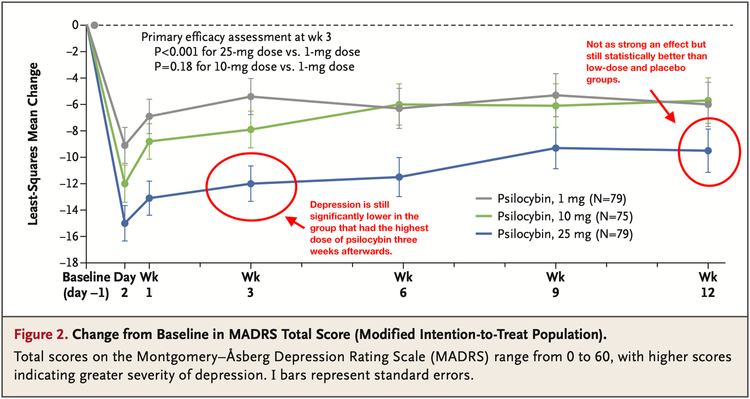Why Psychedelics Can be Emotionally Healing
I guess I should begin by saying that psychedelics can certainly be emotionally unhealthy. This has been know since nearly the beginning of the psychedelic movement in the 1950s. In fact, psychedelics were originallythought of as psychotomimetics, meaning they were seen to mimic psychotic breaks.
As researchers studied them further, they found that instead they were, as the psychiatrist Stanislav Grof put it, “non-specific amplifiers” of the human psyche. Instead of thinking of LSD, psilocybin, mescaline, and similar compounds as “psychotomimetics,” it was much more accurate to think of them as “psychedelics,” which literally means “mind manifesting.”
If you take psychedelics in an unsafe environment, your mind will try to protect you through fear, hyper-vigilance, and aggression, and these thoughts and feelings will be “manifested” (to use the etymology of psychedelics) in your consciousness. In this case, psychedelics can be emotionally unhealthy because it’s much healthier to be sober in an unsafe environment than in an altered state of consciousness.
But if you are in a safe environment, guided and supported by trained, experienced facilitators, then the available evidence suggests that psychedelics can be powerful catalysts for emotional healing and personal growth. Even in a perfect setting, there are still risks involved. In the largest psychedelic clinical trial to report “adverse events” (research terminology referring to negative things that happened during or immediately after the research intervention), researchers found that most people experienced mild ones like headaches and nausea, but there wasn’t a big difference between adverse events for those who had the highest dose (84%) and those with a placebo dose (72%). But it’s important to keep in mind that this trial was with individuals with severe, treatment-resistant depression.
It’s even more important to weigh these risks against the benefits. Here are the results from a single dose of psilocybin in the clinical trial linked above. Depression levels for those who had the highest does are represented by the blue line. The medium and placebo dose are the green and grey lines, respectively. My notes are in red.
There are many other smaller trials that have shown similar but even stronger effects even from just one or two doses. And this is all with minimal psychotherapy, typically a few sessions before and after, added to the dosing.
So what’s going on here? Why can psychedelics have this emotionally healing effect? I’ll present the top hypotheses of researchers and then present my own take.
Increased neuroplasticity. Psychedelics have been shown to increase the connectivity and flexibility of the brain's neural networks. This can help to push pause on old patterns of thinking and behavior, creating new neural pathways associated with therapeutic aims of increased agency, meaning, and social connection.
Reduced activity in the default mode network (DNM). The default mode network is a group of brain regions that are active when we are not engaged in any specific task. It is thought to be involved in self-referential thoughts and rumination. Psychedelics have been shown to reduce activity in this network, which can bring us more into the present moment, outwardly focused on others, and more engaged in our life projects.
Increased connectivity between the amygdala and the cortex. The amygdala is a region of the brain that is involved in processing fear and emotions. The cortex is involved in higher-order thinking and decision-making. Psychedelics have been shown to increase connectivity between these two regions, which can help to reduce fear and anxiety, and promote a sense of calm agency.
Increased release of neurotrophins. Neurotrophins are proteins that promote the growth and development of neurons. Psychedelics have been shown to increase the release of neurotrophins, which can help to repair and protect damaged neurons.
Re-opening critical phases of learning in the brain. The research of Gül Dolan at Johns Hopkins has garnered a lot of attention with an appearance on the Tim Ferriss Podcast and a feature in WIRED. She’s shown that psychedelics re-open pathways of learning in the brain that are usually only open in childhood. In the right environment, this can allow relearning how to connect with others and oneself.
All of these are perfectly valid hypotheses for the beneficial effects of psychedelics. They all help to explain how just one or two doses with minimal therapy can have such profoundly positive effects. But I believe there are also experiential things happening, beyond the neuropharmacology. So, I’d like to add three more non-pharmacological hypotheses:
Getting in touch with your baggage. As “mind-manifesting” “non-specific amplifiers” of our internal worlds, psychedelics help us feel, see, hear, and understand parts of us that have been repressed and locked away (what we’d call “exiled” in Internal Family Systems). If we are supported by experienced facilitators in a safe setting, we have the courage and resources to go to these repressed parts and witness them with compassion and calmness.
All inner parts of you get to connect with each other. This witnessing allows all of our other parts to relax and accept these repressed parts, which leads to a sense of greater internal harmony, ease, and confidence.
Your heart becomes unusually open. As our parts ease, our heart (or Spirit, Soul, Self, Source, or whatever you want to call it) has more space inside and we begin to feel its natural expansiveness, flow, love, and connection.
For me, the neuropharmacology of psychedelics is like analyzing the sound waves of a beautiful song. It’s certainly one way to look at music, but what we really want to know is how did that song make you feel? How did it move you? What did it leave you with?
The experiential aspect is what we really want to know. And it’s what makes me so excited about working in this space in my personal IFS coaching practice, as well as with the Yes Collective.


